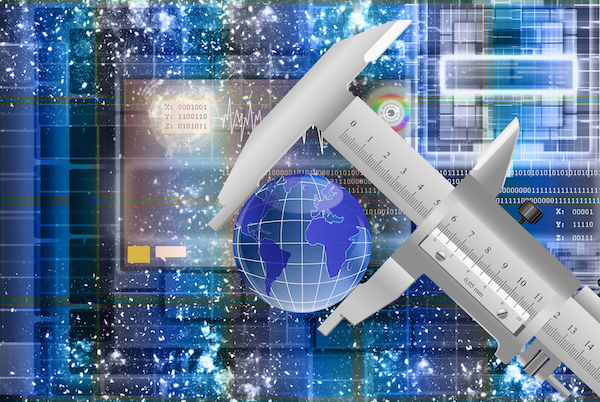Metrology – the scientific study of measurement – has been around a long time. The first known attempt at creating a standard of measure came nearly 5,000 years ago in Egypt.
The unit of measure, called a cubit, was modeled in black granite based on the length of Pharaoh’s forearm and hand. Pyramid builders using sticks or granite pieces of a standard cubit length achieved amazing results. Their accuracy exceeded .05%.
Scientists and engineers have spent the intervening centuries trying to improve their ability to calibrate and measure our world more precisely and in tinier and tinier units – from meters to centimeters to millimeters to micrometers to nanometers. The advancement of science could not exist without the advancement of metrology.
Getting Small
Scientists operating at the cutting edge of technology work more and more often with materials on a nanoscale. Biomedical sciences, telecommunications, aerospace, and other disciplines are seeing and manipulating a world so tiny it’s almost beyond comprehension.
A nanometer is 1 billionth of a meter. To get an idea of just how miniscule a nanometer is, if everyone on the entire planet was the size of a nanometer, all 8 million of us could squeeze into a single matchbox car.
Now that you have an appreciation for the scale, you’re ready for the really tricky part. It’s not so much that scientists are dealing adeptly with smaller and smaller things, but they are learning the workings and properties of nanomaterials and how manipulating something at a nanolevel can affect outsized changes.
When you think about it, biology itself works on a nanoscale. A DNA strand is roughly 2.5 nanometers wide. Most atoms are .1 to .5 nanometers.
Nanomedicine is beginning to operate at that level with a goal of creating drugs that target areas precisely and require a smaller dose; nanomaterials are being experimented with to provide more sophisticated diagnostic and monitoring tools.
The large surface area-to-volume ratio of nanoscale materials offers improved reactivity, accelerating chemical reactions. Highly effective catalysts, nanomaterials are fueling better catalytic converters, batteries, fuel cells and more.
AI Plus Metrology? The Sky’s the Limit
None of this would be possible, however, without metrology. Innovation in metrology has made possible the increased precision demanded for work on superconductors, microelectronics, quantum computing, manufacturing, and biomedicine.
When AI is applied to metrology it opens up a whole new world of possibilities for predicting, making decisions, and optimizing processes and products. AI can handle a tremendous quantity of data and becomes smarter as the amount of historical data increases.
In coordinate metrology, the feedback between sensors and objects or processes in the Internet of Things creates an unending data loop, allowing AI to recognize patterns that can be used to predict failure and identify defects. This can be used to help with preventive maintenance and machine calibration.
On the R&D side, pairing metrology and AI makes innovation faster and more cost-effective. Digital twins come into play here, acting as simulators. Accurate digital twins spark invention, guide design, and can act as prototypes, often eliminating the time and expense of creating an actual physical prototype from raw materials. Because design and testing can be done safely in the virtual world, the time between idea conception and realization compresses.
As metrology forges ahead alongside AI, we can expect to see the visions of scientists across an array of disciplines realized. What began with the measurement of an ancient ruler’s arm continues five millennia later. As long as humans require precision, metrology will continue to advance.
Darling Geomatics, long a leader in high-tech geospatial land surveying and measurement services, is at the cutting edge of metrology; driving innovation and employing laser trackers, including surphasers and proprietary, next-gen equipment to capture precise sub-millimeter measurements.

